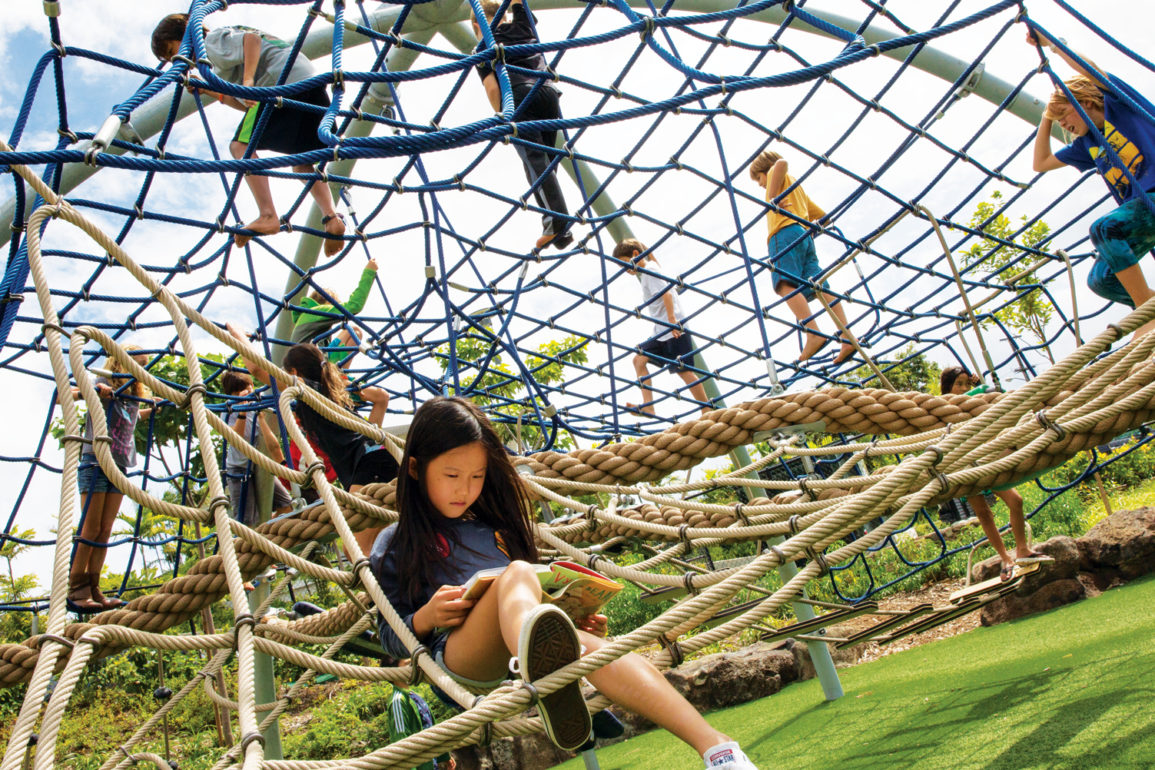Story and photos by Rachel Breitweser ’03
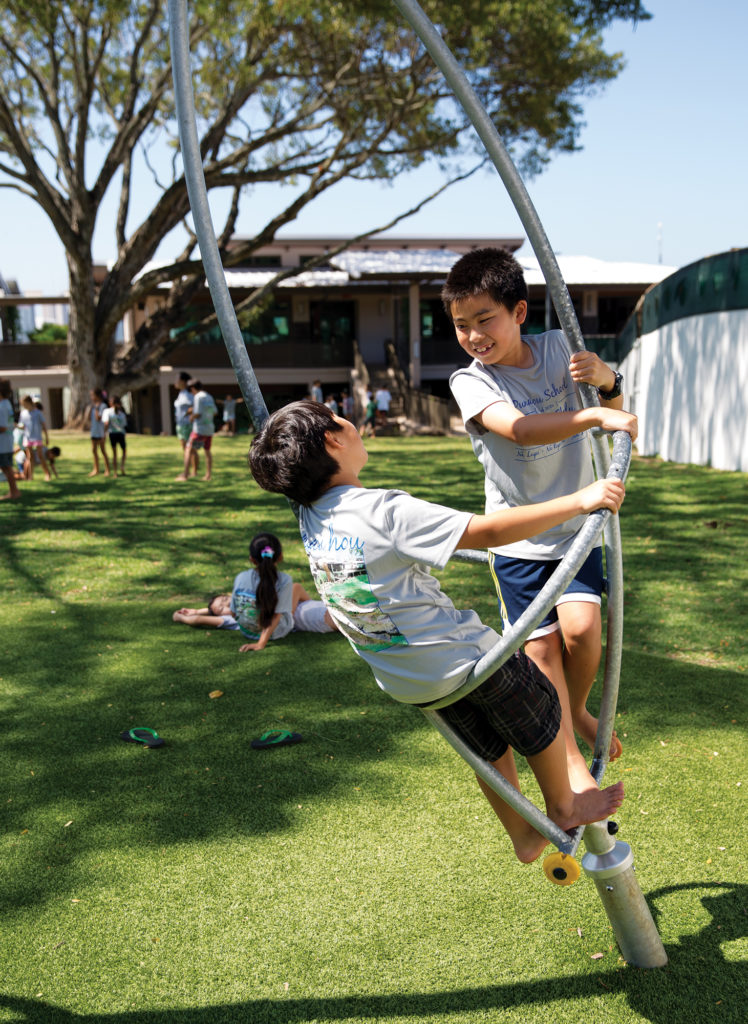
At Barwick Playground in Kosasa Community, Radhika Sarkar ’18, a junior, is sitting on the ground beneath the “Explorer Dome,” an arching dome of interconnected ropes, bars and netting. Second- and third-graders are suspended above her, chatting, climbing and laughing. They peer down at her upturned face, engaging her in conversation. One lowers herself through the network of scaffolding and plops down in her lap. Radhika hugs her and she giggles. On the other side of the playground, students use their body weight to spin round and round on the kinetic “Galaxy Spinner.” Others hang upside down holding onto a framework of bars by their knees.
Across campus in front of Bishop Hall, the newest campus play structure, which was a gift from the O-Men to Punahou, is alive with activity. Students are perched at the top of the two giant blue structures crisscrossed with a network of ropes. Others are swinging on the rope bridge, which connects the two features. Another group is engaged in a game of tag that incorporates both the structure and the field. Still others are relaxing at the foot of the form or doing cartwheels on the springy synthetic turf.
The look and feel of these play structures is vastly different from the age-old classics of slides, swings, monkey bars and seesaws. While parents may be nostalgic for the playgrounds they grew up with, modern play structures are paving the way for new types of childhood experiences and development.
“There’s really been an expansion of sensory experiences with advances in new materials,” explained Junior School Principal Dr. Paris Priore-Kim ’76, “It’s gone beyond metal piping and now includes different textures, surfaces, different ways of accessing the structures and multiple ways of experiencing them.”
I like the spinners because it’s like the ride Area 51 – it kinda feels like we’re at Carnival all year.
Cali Asato ’27
No Wrong Way to Play
On the playground, there’s more going on than meets the eye. In fact, playgrounds and play structures themselves, with their physical- and social-skill-building opportunities, are learning environments all their own. On the new equipment, these skills flourish. “Kids learn coordination, which can even improve the brain’s receptivity to learning and reading,” explained John Nagel ’90, grades 3 and 5 supervisor.
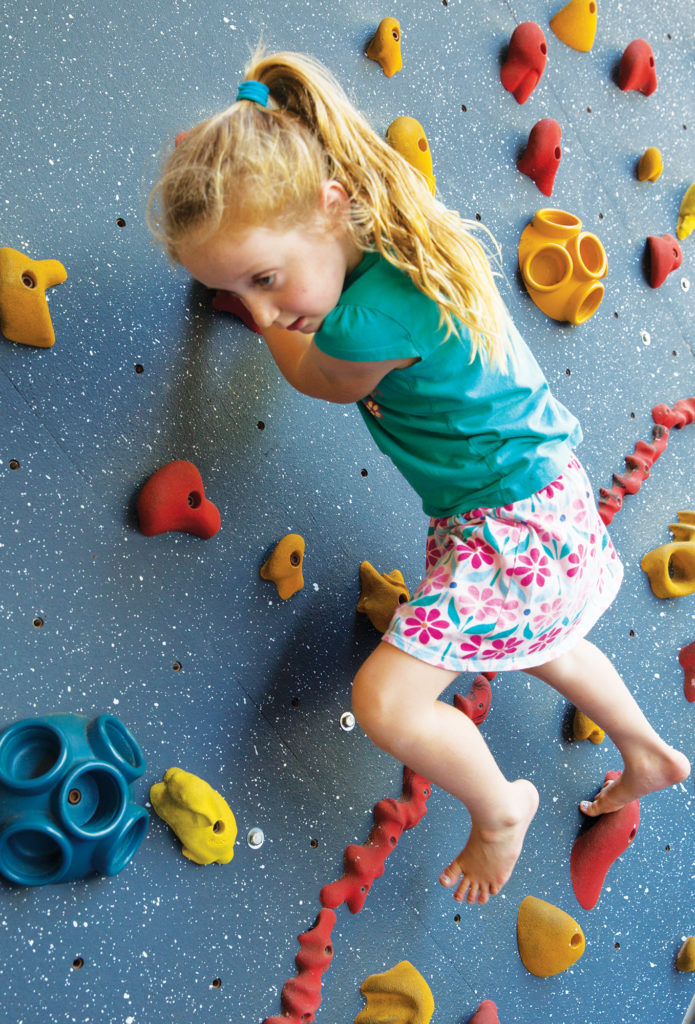
One thing becomes immediately clear when observing these new play structures. With the climbing networks, the mixture of materials, the multiple connections and niches within the equipment, there is no wrong way to play. It’s open-ended.
While a swing is a swing and a slide a slide, these new structures are blank canvases on which children can use their imaginations. “The equipment follows the Junior School pedagogy, which is all about discovery,” said Julie Crane-Cory, grades 2 and 4 supervisor, who with Nagel selected the new structures. “They are designed to promote creativity.”
The different physical spaces and features appeal to students of multiple ages and varied skill levels. “They offer something for children’s different interests, choices and disposition. Students can jump, swing, spin, lie on their tummies underneath or explore. There is so much for a child to choose from depending on what that child needs that day,” said Priore-Kim. “It’s giving opportunity to kids that might not have had a place to play before,” added Nagel.
As an adult standing at the bottom of one of these play structures, a look up can inspire fear. Yet despite their towering features, these new types of structures are extremely safe.
“Safety is always the No. 1 priority and considered from the beginning,” said Nagel. It is in a child’s nature to explore every iteration of engagement with playground materials. In the case of swings, twisting up the seats and spinning into others becomes a safety issue. Since the new structures stimulate children in a number of different styles, there are fewer ways for students to misuse the equipment in unsafe ways.
With safety considered, when children can take chances, it’s a rich source of learning. “Play structures provide kids with avenues for exploring risk: being high off the ground and what it feels like to be unstable,” said Priore-Kim.
While students are exploring and improving gross motor skills, balance and spatial perception, playing with gravity, and studying the cause and effect of physics, they’re also gaining fitness and creating a healthy habit of active living. In fact, Crane-Cory and Nagel selected equipment based on observations from PE teachers that suggested students could benefit from improving their upper body strength, hence the many climbing opportunities available.
Collaboration, Creativity and Communication
In addition to the physical benefits, the new play structures create space for social learning. Whereas four swings can accommodate four children, the new structures invite more children to play and socialize. Playgrounds become microcosms of the real world where students experience the freedom of making connections and also learn the boundaries that come with respecting others.
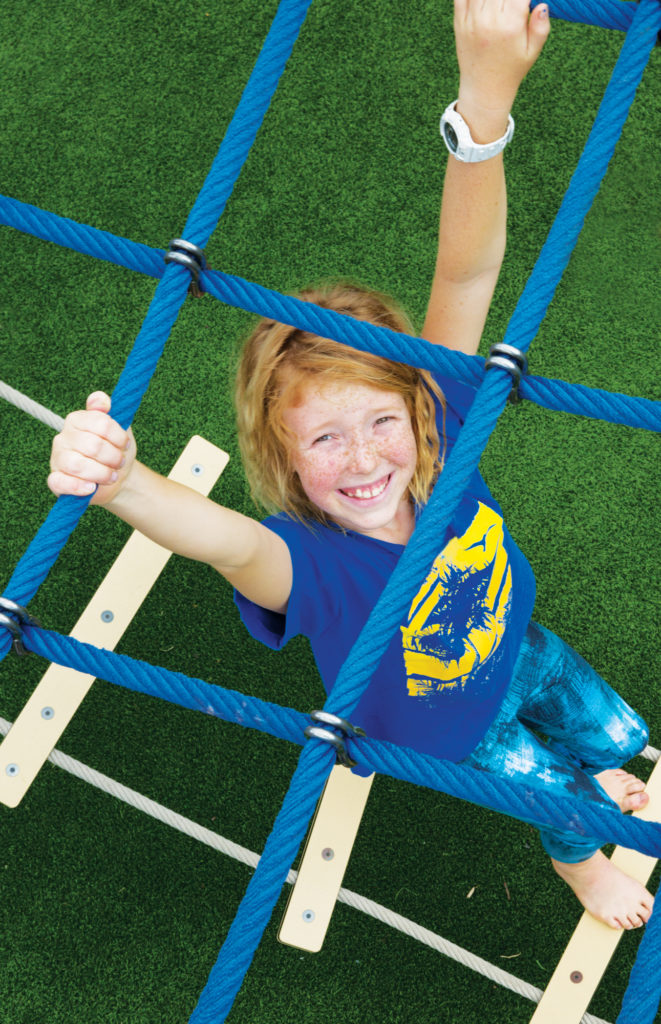
“On a rope bridge, for example, your movement affects other people’s movement so you’re impacting another child’s experience,” said Priore-Kim. “When a kid jumps on the bridge that another kid is on, there’s communication and social negotiation that’s going to happen.”
Interaction is also taking place across grade levels, especially at the O-Men structure, which draws students in grades 4 – 8. Fourth-graders Madeleine Wagner and Skyelach Nichols-Shipley, two precocious climbers, were quick to share they’ve made new friends through playing on the equipment with older students.
There’s also a different style of leadership these types of environments promote. Nagel, referencing research in this field of child development, explains how on flat, open areas of space, children organize themselves on Darwinian principles, where strength and assertiveness distinguish the leaders. In varied environments, a more creative-based leadership forms out of make-believe and the creation of new games.
Confidence gained with physical mastery during play results in more independent children, and it promotes a different type of relationship with their teachers than “adult supervision” does. “The equipment encourages interactivity, so there’s more opportunity for kids to work things out themselves,” said Priore-Kim. “Teachers can step back and allow a lot of that interaction to happen itself.”
Author, innovation expert and recent guest speaker at Punahou, Dr. Tony Wagner, corroborates the value of play as a way for youngsters to find their passions in life. He describes the pattern of “play to passion to purpose.” When given access to unstructured playtime and exploratory play, a child’s natural curiosity will lead them to discover their calling in life. The collaboration happening on the playground also plants the seeds for a future career. “The world of innovation demands collaboration,” Wagner explained.
Leaps and Bounds
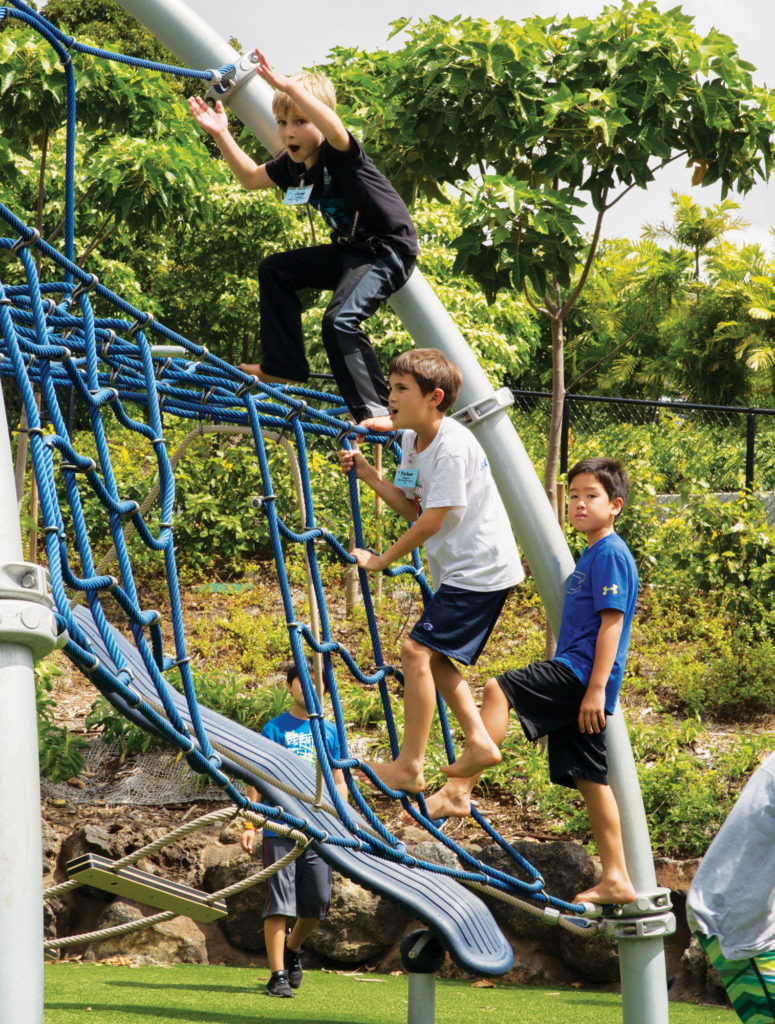
With the continued development of Kosasa Community, students have more new play structures to look forward to, including one with a circular platform that students can climb to, a tire swing, multiple slides with one that several students can go down at once. Another future structure is a treehouse that will be built in the long-standing mahogany tree on Barwick Playground.
Academy teacher and architect Keith Cockett’s ’81 students took the lead on the concept and design of the treehouse. High-school students worked with Junior School students to get their ideas about how the new play structure might look. The younger students were then able to vote on the top design. The School is targeting completion of the treehouse in 2018, and the structure will incorporate repurposed wood from the Winne Units.
One facet of the reimagined Junior School playground that will not be new is the beloved Banyan Tree. Its legendary boughs will continue to delight generations of students once construction of Kosasa Community is complete.
In addition to the exciting new play structures, Punahou’s natural elements, from the Lily Pond to Rocky Hill, will remain important locations for learning and diversion. “We want to explore all the opportunities of how we can expand intentional outdoor learning here on campus,” Priore-Kim said.
Quiz: What’s your play structure personality?
Want to be one with nature?
Trace the movement of water in the Kosasa Community ‘auwai, the natural bioswales that channel rainwater.
Like seeing the whole picture?
You’ll feel at home at the top of “Explorer Dome” at Kosasa Community or the O-Men structure on Rice field.
Craving some off-the-wall fun?
The Omidyar K — 1 rock climbing wall is the place for you.
Wish Carnival rides were up year-round?
Get dizzy on the “Galaxy Spinner” at Kosasa Community.

